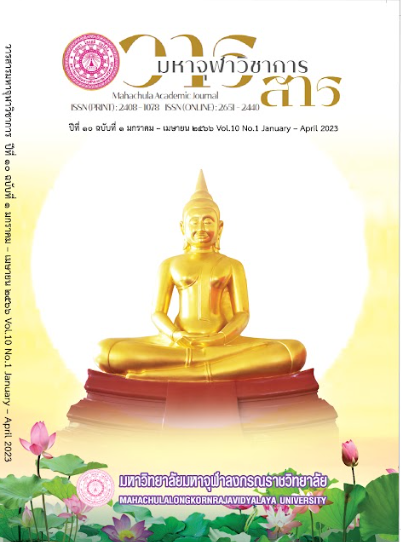Dhamma Learning through Artistry : The Case Study of Buddhachinaraj
Main Article Content
Abstract
The Buddhist artistry developed from 4 kinds of stūpa, i.e. stupa containing relics (Dhātu), stupa as thing used by the Buddha (Paibhogajetī), stupa containing Dhamma (Dhammajetī) and stupa dedicating the Buddha (Uddesikajetī) and developed from persons worthy of a stupa or monument in 4 kinds, i.e. the Buddha, the private Buddha, the Buddha’s follower and an emperor including the holy 4 places (Saṁvejanīyasathan), i.e. the place of Birth; the Lumpini, the place of Enlightenment; Bodhigayā, the place of the first sermon; Sāranātha and the place of passing a way; Kusinārā. These things and places are guided in settlement of 4 junction roads as origins of respected things or the holy places regarded in Buddhism. In which, this is the way doing for the dead body of the Buddha who says to the most Venerable Ananda as for ‘Ananda, a scholar should do my dead body in the same way with the emperor’s dead body and then the dead body after burning should contain it in 4 junction roads. This is important to make us find that construction and settlement as the Buddhist artistry for monument in the Triple Gem leading to faith, credit, paying respect, worship then into wisdom for the development of living quality according to Dhamma media in the Buddha’s saying that ‘anyone sees Dhamma, that one sees me / anyone sees me, that one sees Dhamma’. To have an art is to have property without stealing. The art is a good friend in this world and leads happiness to us in the next. Although the art for example the Buddha Image as a representative and any artist sculpts the Buddha in a various different model of face. That is not important, but depends on 3 kinds of grace of the Buddha, i.e. the wisdom’s grace, the purification’s grace and the compassion’s grace. Wherein. the Buddha is a knower, a waken One, a bloom One, Dhamma directs a way of Dhamma for the riddance of ignorance and the Saṅgha is a model of living regarded as noble refuge and freedom from rebirth being organized as the factor of knowledge for learning of Dhamma through this artistry, i.e. ‘Knowledge of Dhamma, Artistry of intellect then leading to the quality of life’.
Article Details

This work is licensed under a Creative Commons Attribution-NonCommercial-NoDerivatives 4.0 International License.
References
ชฎาลักษณ์ สรรพานิช. “พระมาลัย : การศึกษาเชิงวิเคราะห์”. วิทยานิพนธ์ศิลปศาสตรมหาบัณฑิต. บัณฑิตวิทยาลัยมหาวิทยาลัยศิลปากร, ๒๕๒๔.
เทวัญ เอกจันทร์ และคณะ. การสังเคราะห์องค์ความรู้พุทธศิลปกรรมในล้านนา”. รายงานวิจัย. มหาวิทยาลัยมหาจุฬาลงกรณราชวิทยาลัย, ๒๕๖๓.
ทศพล จังพานิชย์กุล. พระพุทธรูป. กรุงเทพมหานคร: สำนักพิมพ์คอมมา, ๒๕๔๖.
พระเมธีธรรมาภรณ์ (ประยูร ธมฺมจิตฺโต). อนุทินธรรมะ : ธรรมะสำหรับ ๓๖๕ วัน. กรุงเทพมหานคร: บริษัทสหธรรมิก จำกัด, ๒๕๓๙.
พระศรีคัมภีรญาณ (สมจินต์ สมฺมาปญฺโญ). พระพุทธศาสนา ปรัชญา-สังคม.กรุงเทพมหานคร: อาทรการพิมพ์, ๒๕๕๑.
พระครูสิริรัตนานุวัตร (ทวี ฐานวโร). พุทธศิลป์พุทธธรรม. พิษณุโลก: โฟกัสปริ้นต์, ๒๕๖๖.
__________. ศาสตร์ร่วมสังคม. พิษณุโลก: โฟกัสปริ้นต์, ๒๕๕๕.
__________. “การศึกษาตีความพุทธธรรมที่ปรากฏในศิลปกรรม”. รายงานวิจัย. มหาวิทยาลัยมหาจุฬาลงกรณราชวิทยาลัย, ๒๕๕๗.
พระมหาสุทิตย์ อาภากโร. “การพัฒนารูปแบบและกระบวนการจัดการท่องเที่ยวทางพระพุทธศาสนาในประเทศ”. รายงานวิจัย. กรุงเทพมหานคร: สำนักงานกองทุนสนับสนุนการวิจัย, ๒๕๕๗.
พระมหาจีรวัฒน์ กนฺตวณฺโณ. พุทธศิลป์พุทธชินราช. พระนครศรีอยุธยา: โรงพิมพ์มหาจุฬาลงกรณราชวิทยาลัย, ๒๕๖๑.
มหาจุฬาลงกรณราชวิทยาลัย. พระไตรปิฎกภาษาไทย ฉบับมหาจุฬาลงกรราชวิทยาลัย. กรุงเทพมหานคร: โรงพิมพ์มหาจุฬาลงกรราชวิทยาลัย, ๒๕๓๙.
ศิลป์ พีระศรี. คุณค่าของจิตรกรรมฝาผนัง. พระนคร: กรมศิลปากร, ๒๕๐๒.
สมเด็จพระพุทธโฆษาจารย์ (ป. อ. ปยุตฺโต). พจนานุกรมพุทธศาสน์ ฉบับประมวลศัพท์. พิมพ์ครั้งที่ ๓๒. กรุงเทพมหานคร: โรงพิมพ์มหาจุฬาลงกรณราชวิทยาลัย, ๒๕๔๖.
สงวน รอดบุญ. ศิลปกรรมไทย. กรุงเทพมหานคร: โรงพิมพ์การศาสนา, ๒๕๔๒.
“เกร็ดความรู้จากสารานุกรมไทย” [ออนไลน์]. แหล่งที่มา: https://ww.baanjomyut.com
พระมาลัยโปรดนรก-กาเมสุมิจฉาจาร. [ออนไลน์]. แหล่งที่มา: http://www.tairomdham.net/index.php?topic=6948.0.
พระศรีคัมภีรญาณ (สมจินต์ สมฺมาปญฺโญ). กำเนิดและพัฒนาการแห่งพระพุทธรูป เรื่อง การสร้างพระพุทธรูปในอินเดีย.[ออนไลน์]. แหล่งที่มา: <http://www.mcu.ac.th/site/articlecontent>.
“รู้อะไรให้กระจ่างแต่อย่างเดียว ขอให้เชี่ยวชาญเถิดจะเกิดผล”. [ออนไลน์]. แหล่งที่มา: https://www.thaicyberpoint.com.
เราจะครองแผ่นดินโดยธรรม-เพื่อประโยชน์สุขแห่งมหาชนชาวสยาม [ออนไลน์]. แหล่งที่มา: https://www.luehistory.com.
สุภาษิต ปรัชญา ปณิธาน วิสัยทัศน์ และพันธกิจ. [ออนไลน์]. แหล่งที่มา : https://www.mcu.ac.th/pages/philosophy-commitment-vision-mission.


